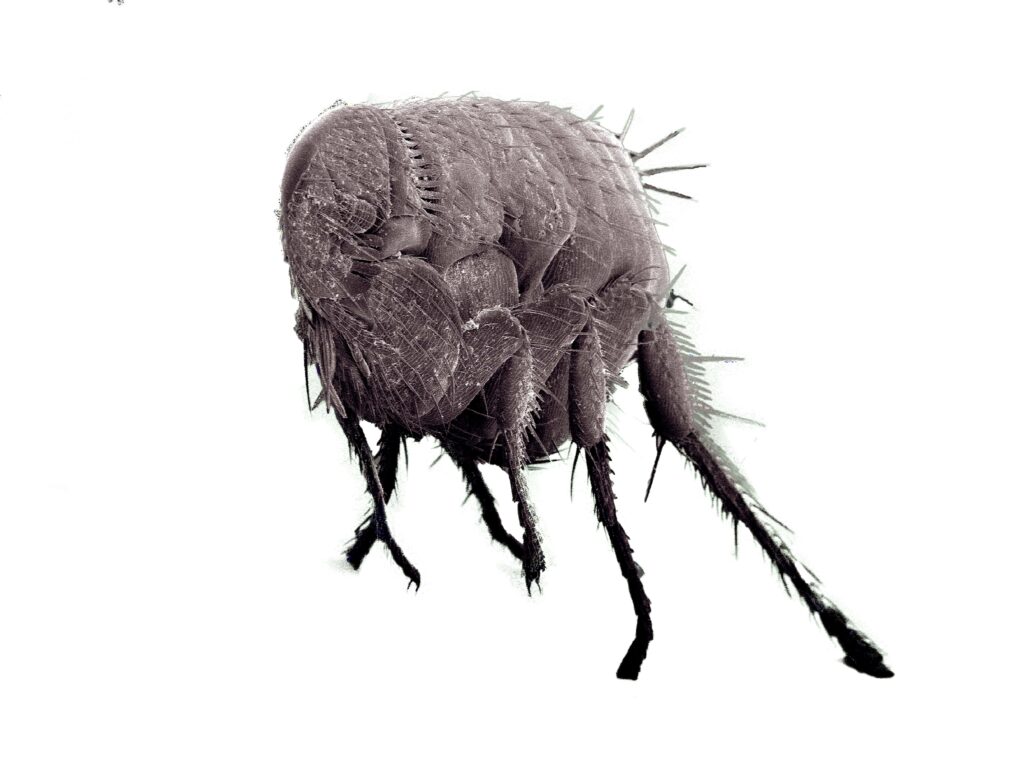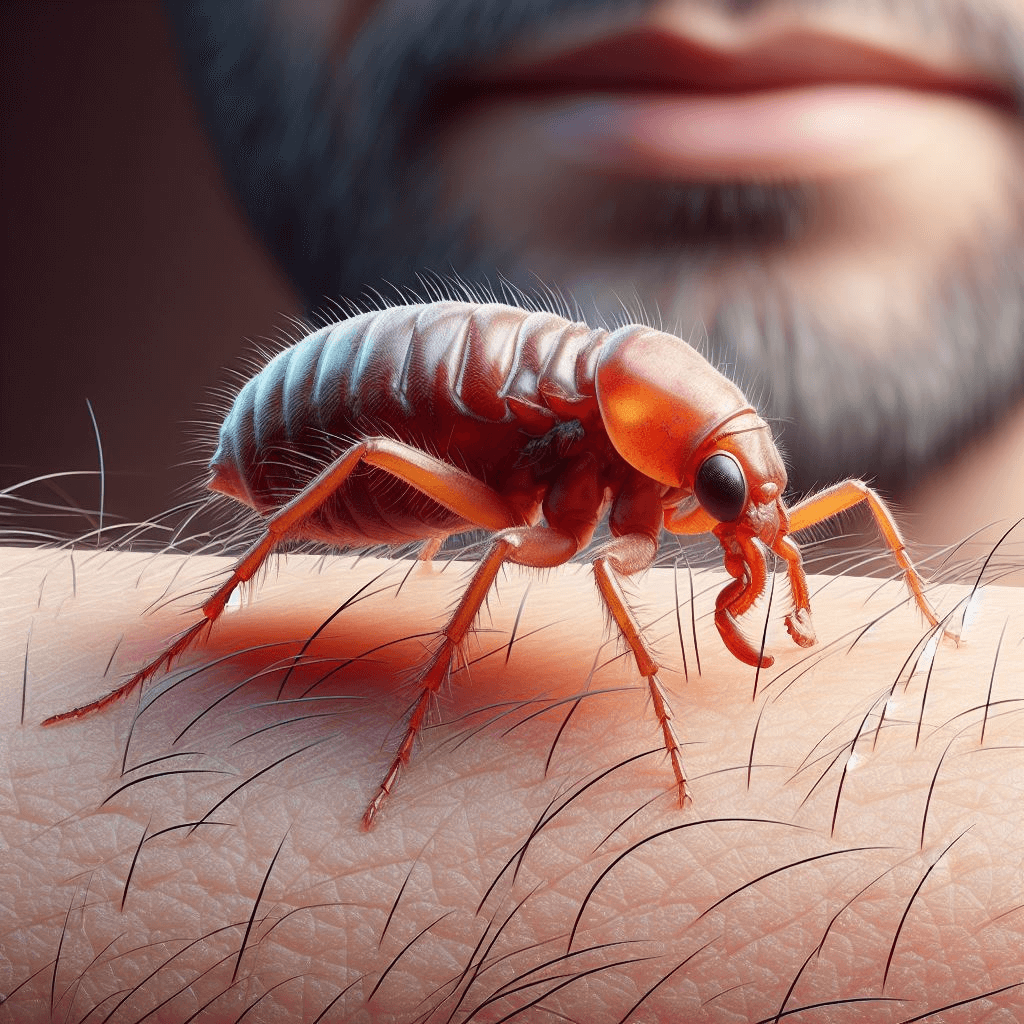Picture this: you’re cozily petting your beloved feline friend when suddenly, a tiny, agile creature jumps from their fur onto your unsuspecting arm. You squint at it, and there it is—a flea!
These minuscule pests are incredibly skilled at hitching a ride on our furry companions, causing discomfort and annoyance for both pets and humans alike. But have you ever wondered if these pesky creatures can do more than just make us itch?
Can fleas actually transmit diseases to humans? Let’s dive into the world of these blood-sucking creatures to find out.
Fleas are small wingless insects that belong to the order Siphonaptera—quite a mouthful! They have flat bodies designed for effortlessly navigating through hair or fur.
While there are numerous species of fleas worldwide, the most common ones that infest our furry friends are known as cat fleas (scientifically called Ctenocephalides felis). Despite their name, these critters do not limit themselves solely to cats; they frequently latch onto dogs and other warm-blooded animals as well.
Nowadays, flea infestations are quite prevalent among pets and can quickly become a nuisance within households. These tiny vampires feed on the blood of their hosts in order to survive and reproduce.
Adult fleas lay eggs which then hatch into larvae within your pet’s environment – be it carpet fibers or bedding materials. After undergoing several developmental stages, they transform into adult fleas ready to hop onto any nearby host in search of another meal.
Can Fleas Infect Us Humans?

So here comes the million-dollar question: can fleas transmit diseases to humans? Unfortunately, the answer is yes—with a twist.
While fleas might not directly infect us with illnesses like some notorious mosquito species do, they can still play an indirect role in transmitting certain diseases. How?
Well, it all boils down to their feeding habits and the pathogens they carry. When fleas bite an infected animal, be it a pet or a wild creature, they can ingest disease-causing microorganisms along with their blood meal.
These pathogens, which may include bacteria, parasites, or even viruses, find a cozy home inside the flea’s gut. As the flea moves on to its next host for another bite—let’s say that unsuspecting human—they can potentially transmit these pathogens through their saliva into the fresh wound caused by their bite.
However, it’s crucial to note that although fleas can carry harmful microorganisms within them, not all flea bites will lead to human infection. The risk of contracting a disease from fleas depends on various factors such as geographical location and personal hygiene practices.
Certain flea-borne diseases are more prevalent in specific regions or environments—rural areas or places with high populations of infected animals generally pose an increased risk. Intriguingly enough, despite being known as “cat fleas,” these pesky insects don’t limit themselves solely to feline hosts.
They opportunistically latch onto any warm-blooded creatures available—whether it be our beloved pets or us humans—making it essential for us to understand the potential risks involved and take necessary precautions. So buckle up as we explore the fascinating world of flea-borne diseases and uncover how these tiny critters might impact our lives!
Flea-borne diseases: An overview
Mention common flea-borne diseases in animals (e.g., cats, dogs)
Fleas are not just creepy crawlers that irritate our pets; they can also pose a threat to their health. Cats and dogs are particularly susceptible to flea diseases and to various flea-borne diseases.
One infamous culprit is the ctenocephalides felis, commonly known as the cat flea. These tiny insects thrive on blood meals from our furry companions, causing intense discomfort and potential health complications.
For both dogs and cats, one of the common diseases transmitted by fleas is flea-borne typhus. This disease is caused by Rickettsia bacteria and can lead to a range of symptoms including fever, muscle pain, and severe itching.
If left untreated, it may result in secondary infections or even more serious complications. Similarly, cats can also suffer from similar flea-borne illnesses that affect their overall well-being.
Highlight the potential risk of these diseases spreading to humans
But what about us humans? Can fleas transmit these diseases to us as well?
Unfortunately, the answer is yes. Though they primarily feast on flea feces from other mammals like cats and dogs, fleas can indeed transmit certain pathogens to humans through their bites.
While most commonly associated with historical outbreaks such as the bubonic plague, fleas can still be carriers of harmful bacteria that pose a potential risk to public health today. The transmission of such bacteria occurs when infected female fleas bite humans during their quest for blood meals.
The consequences of contracting these diseases from fleas should not be underestimated. Not only do they cause discomfort through severe itching and allergic reactions but if left untreated or undiagnosed, they can progress into more serious conditions with long-term implications for an individual’s health.
Can fleas transmit diseases to humans?

Murine typhus: The stealthy threat
One such disease transmitted by fleas that can affect humans is murine typhus. While not as well-known as the bubonic plague, it is a stealthy threat that should not be ignored.
Fleas infected with Rickettsia typhi, the bacteria responsible for murine typhus, transmit the disease to humans through their bites. Symptoms of murine typhus in humans include fever, headache, and muscle pain.
If left untreated, it can progress to more severe complications affecting vital organs. In areas where flea infestations are common or there is increased contact with infected animals like rats and opossums, the risk of transmission of disease to humans is significantly heightened.
Cat scratch disease: A feline connection
Another intriguing and lesser-known condition related to fleas is cat scratch disease (CSD). As the name suggests, this illness primarily stems from interactions with the infected fleas on cats rather than direct flea bites.
However, it’s important to note that fleas play a role in transmitting Bartonella bacteria — the culprit behind CSD — from cats to humans. When an infected cat scratches or bites during play or grooming sessions, fleas present on their fur can easily transfer bacteria onto human skin.
Symptoms of CSD typically include swollen lymph nodes near the site of injury or scratch and may also involve fever and fatigue. Though usually self-limiting in healthy individuals, severe cases may require medical intervention.
By understanding these common flea-borne diseases in animals and their potential risk of spreading to humans, we can take appropriate measures to protect ourselves and our furry friends from potential harm. Stay tuned for further sections on prevention and control strategies against fleas’ insidious threats!
The Mechanics of Flea Transmission

Explanation of how fleas feed on blood from hosts
When it comes to feeding, fleas are tiny but mighty creatures. They have developed a specialized feeding process that allows them to sustain themselves on the blood of their host animals, including humans. The first step in this process is finding a suitable host.
Fleas have an incredible ability to detect and locate warm-blooded animals, using their keen sense of smell and body heat detection. Once a flea finds its target, it uses its powerful hind legs to jump onto the host’s body.
From there, it quickly navigates through the fur or clothing until it reaches the skin surface. Fleas use their mouthparts to pierce the skin and initiate the feeding process.
Detailing the anatomy of a flea’s mouthparts and feeding process
A flea’s mouthparts are specially designed for piercing and sucking blood from its hosts. At the tip of their mouthparts, fleas possess a sharp stylet-like structure called a “labium.” This labium acts as a needle that penetrates the skin, creating a bite wound and an opening for blood extraction. Once they have punctured the skin successfully, fleas insert two additional parts called “maxillae” into the wound.
These maxillae have tiny saw-like structures that help anchor the flea in place during feeding. The maxillae also release anticoagulant saliva into the bloodstream to prevent clotting and ensure continuous blood flow for sustenance.
As fleas feed on blood, they become engorged with their meal—a necessity for their survival and reproduction. After completing their meal, they detach from their host and retreat back into their habitat until hunger strikes again.
Highlighting their preference for warm-blooded animals, including humans
Fleas show a strong preference for warm-blooded animals, including humans. They have evolved to thrive on the blood of mammals, making our furry friends and us potential hosts.
However, it is important to note that fleas generally prefer the blood of animals with fur or hair, as it provides easier hiding places and more secure attachments for feeding. While fleas may infest many animals like dogs, cats, and rodents, they can also target humans if given the opportunity.
These pesky parasites are not deterred by our species and will seize any chance to feed on exposed skin or infest our living spaces. Their ability to jump rapidly from host to host increases the risk of flea-borne diseases being transmitted between animals and humans.
Therefore, preventing human flea- flea-infestations in both pets and homes becomes crucial in minimizing potential health risks associated with these tiny pests. Now that we understand how fleas feed on blood from their hosts and their preference for warm-blooded creatures like humans, let’s delve into the specific diseases these little critters can transmit to us in the next section.
Flea-borne diseases that can affect humans
Plague: The notorious disease transmitted by fleas throughout history
Ah, the plague — a word that sends shivers down one’s spine and conjures images of historical pandemics and widespread devastation. As we delve into the topic of fleas transmitting diseases to humans, it is impossible not to mention the notorious plague.
This disease caused by the Yersinia pestis bacteria has plagued humanity for centuries, leaving an indelible mark on human populations throughout history. The plague first emerged in the 14th century, known as the Black Death, claiming millions of lives across Europe and Asia.
Fleas played a critical role in spreading this deadly disease. These tiny insects typically infest rats and other small mammals, acting as vectors for Yersinia pestis.
When an infected flea feeds on an animal’s blood, it ingests the bacteria along with it. Subsequently, when the same flea bites a human host, it regurgitates contaminated blood into their bloodstream, facilitating transmission.
Murine typhus: A lesser-known but significant disease transmitted by fleas
While not as widely recognized as the plague, murine typhus remains a significant flea-borne disease that can affect humans and animals. It is caused by Rickettsia typhi bacteria and is primarily transmitted by fleas infesting rats or opossums. Although prevalent worldwide, murine typhus is particularly common in areas with high rat populations such as Southeast Asia.
Symptoms of murine typhus often include fever, headache, body aches, and a rash appearing after several weeks following infection. In some cases, complications may arise affecting various body systems like cardiovascular or respiratory systems if left untreated.
It is important to note that while cats are often associated with another condition called cat scratch disease, they do not play a significant role in the transmission of murine typhus. Instead, it is the often infected cat fleas and rats acting as reservoirs that pose the primary risk for transmitting this flea-borne illness to humans.
Bartonellosis (Cat scratch disease): An intriguing connection between cats, fleas, and humans
Now let’s explore a fascinating and somewhat perplexing connection between cats, fleas, and humans: Bartonellosis, also known as cat scratch disease. This zoonotic disease is caused by Bartonella bacteria and manifests when an infected cat bites into flea saliva or scratches a human, introducing the bacteria into their system via flea bites or direct contact with contaminated cat saliva.
Symptoms of cat scratch disease vary from person to person but commonly include swollen lymph nodes near the affected area along with fever and fatigue. In severe cases of cat scratch fever, individuals may experience body aches and skin lesions.
Cat scratch disease is usually self-limiting in healthy individuals; however, people with weakened immune systems may require medical intervention. Diagnosing Bartonellosis can be challenging due to its nonspecific symptoms.
Medical practitioners often rely on clinical history along with laboratory tests to identify the presence of Bartonella bacteria in patient samples. Treatment involves antibiotics tailored to each individual case.
While fleas may seem like mere nuisances when infesting our pets or homes, it is important to recognize their potential role as vectors for various diseases affecting humans. The plague’s devastating historical impact serves as a stark reminder of the dangers posed by fleas carrying Yersinia pestis bacteria.
Additionally, murine typhus reminds us that even lesser-known diseases transmitted by fleas can cause significant health complications if left untreated. Bartonellosis highlights an intriguing link between cats, fleas, and human health—underscoring the importance of understanding these connections in order to prevent and manage these flea-borne diseases effectively.
So, next time you encounter a flea, remember that it’s not just an irritating bug but a potential carrier of harmful pathogens. Stay vigilant and protect both yourself and your furry friends from the risks they pose.
Prevention and Control Measures

Personal Protection against Flea Bites
To keep those pesky fleas at bay, it’s crucial to take necessary precautions to protect yourself from their bites. Here are some helpful tips to minimize the risk of flea encounters and ensure your well-being:
1. Use Insect Repellents: Grab a bottle of insect repellent containing DEET or picaridin, which are effective against fleas. Apply a thin layer on exposed skin before venturing into areas where fleas may be prevalent, such as grassy parks or wooded trails. Remember to follow the instructions on the label for optimal protection.
2. Wear Protective Clothing: Shield yourself from potential flea bites by wearing long-sleeved shirts, pants tucked into socks, and closed-toe shoes when in high-risk areas. Opt for lighter-colored clothing since fleas are easier to spot on light surfaces.
3. Maintain a Clean Environment: Regularly vacuum your home, paying close attention to upholstered furniture, carpets, and pet bedding that can serve as cozy homes for fleas. Washing your pets’ bedding frequently in hot water also helps eliminate any unwelcome visitors.
4. Protect Your Pets: Keep your furry friends healthy by following veterinarian-recommended flea prevention treatments tailored specifically for dogs or cats—such as topical solutions or oral medication—to ensure they remain free from these bothersome insects.
Conclusion
While the thought of flea-borne diseases may trigger concern, taking proactive measures can significantly reduce the risk of transmission and put your mind at ease. By practicing personal protective techniques like using insect repellents and wearing appropriate clothing in high-risk areas, you can thwart those tiny bloodsuckers’ attempts at making you their next meal. Remember that maintaining a clean environment is essential in combating flea infestations both indoors and outdoors.
Regularly cleaning your living spaces and keeping your pets protected with veterinarian-approved flea prevention measures are crucial steps in preventing fleas from invading your home. By staying vigilant and informed about the risks associated with fleas, you can enjoy a worry-free time outdoors with family and pets while minimizing the chances of encountering these bothersome pests.
So, equip yourself with knowledge and take action against fleas to ensure a healthier environment for you and your loved ones. Stay proactive, and stay protected!
Annihilate Fleas with D-Termination: The Foremost Pest Control Service in Las Vegas!

If you’re grappling with flea issues at your Las Vegas property, rest easy, for D-Termination is here to assist you. Our adept team is highly proficient in eradicating flea infestations and reinstating tranquility and serenity to your premises. Bid farewell to fleas—opt for D-Termination for proficient pest control today!
You can reach us at 702-919-6310 or visit dtermination.com to schedule your flea control service and regain your space from these troublesome pests.
Frequently Asked Questions:
Fleas can transmit diseases such as plague and murine typhus to humans.
Fleas do not pass diseases directly from one human to another; they transmit diseases from animals to humans.
Fleas are not known to transmit Lyme disease to humans; ticks are the primary vectors.
Fleas can cause respiratory problems in humans if a person is allergic to their bites, leading to conditions like flea allergy dermatitis.








